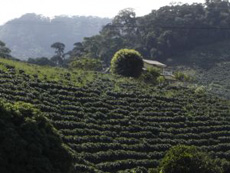TRENDS: Whole Foods Over-Stretches The Definition Of “Local”
| Most food-centric people are interested in “local” foods these days: to support their local family farms; to eat foods in season, when they taste the best; and for environmental reasons, because locally-grown food doesn’t have to be transported long distances, which saves on fossil fuel. While “local” has become a hot marketing word, we think that Whole Foods Market has taken the concept a bit too far. As we walked past the bags of coffee at one of the New York Whole Foods stores this afternoon, we saw two brands produced by New York-area companies, heralded with “local” signs. Militant locavores—restrain yourselves from marching on Whole Foods Market and tearing these signs down. Instead, if you concur with our grievance, complain to the store manager. |  A coffee plantation in Brazil. All coffee beans sold in the continental U.S. are grown elsewhere and shipped here. They are not “local” foods. Photo by Daniel Zandonadi | SXC. |
|
| What’s the grievance? No coffee is grown anywhere in the Continental U.S., so therefore, no coffee can be a “local” product in the sense that the industry uses the term, to apply to products that are farmed, raised or fished locally (only Whole Foods Hawaii can promote Kona and a few other local coffee varieties). Typically, coffee beans for American brands are shipped green to the U.S. from the semitropical country in which they are grown, whether they’re destined for Maxwell House or an artisan label. They do get roasted locally, for freshness; but that’s like saying that macadamia nuts from Australia that are roasted in New York are a “local” product.
So these beans were roasted in New York instead of Seattle. That’s not what “local” means, and to say so is duping customers who want to do the right thing but don’t stop to think that coffee isn’t locally grown. If WFM wants to flag a brand of coffee that roasts the beans locally as “local,” then they’ve got to flag every ice cream, yogurt, jam and other food manufactured in the region as local, regardless of where the ingredients come from. At least the local ice cream and yogurt makers are using local milk! |
||


